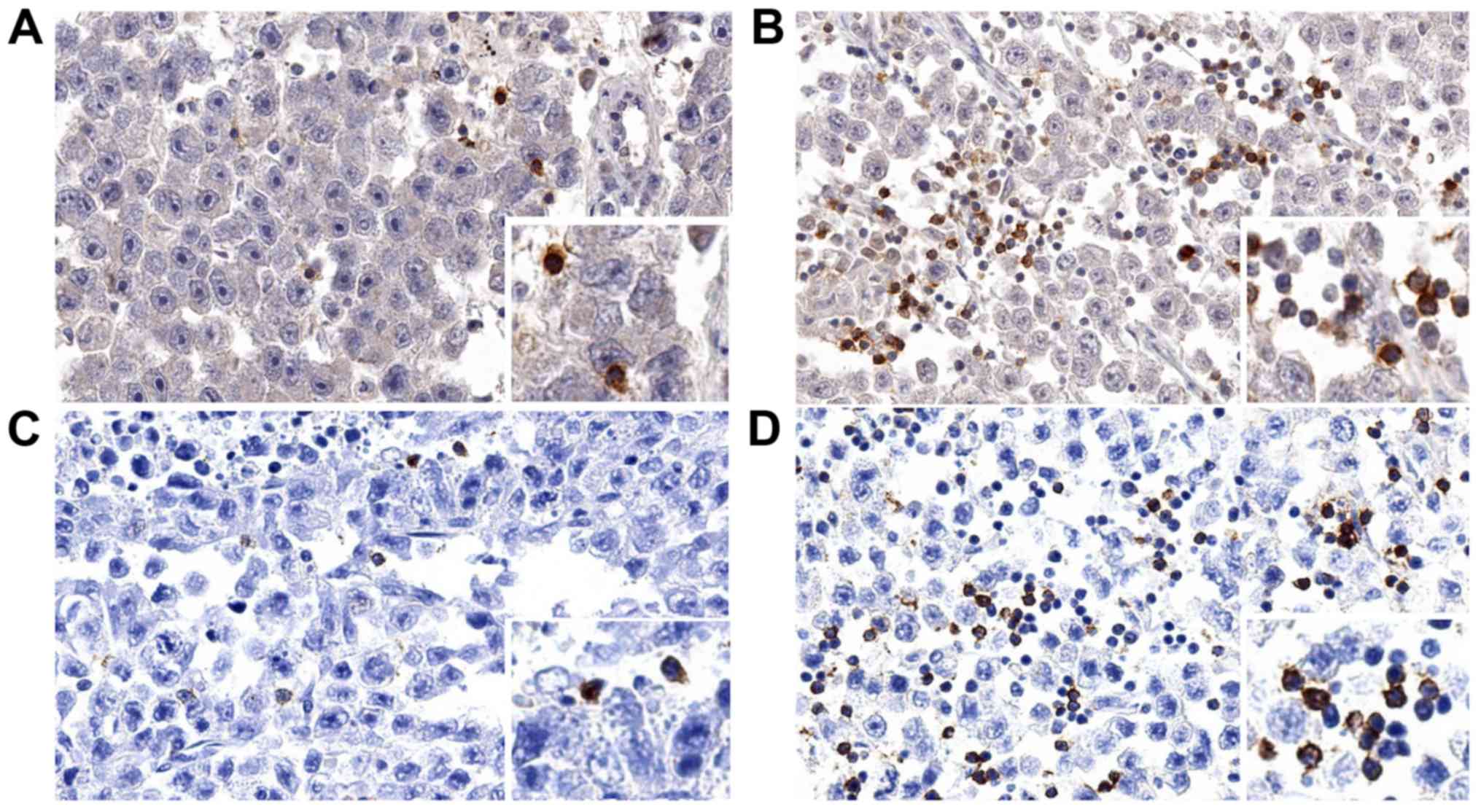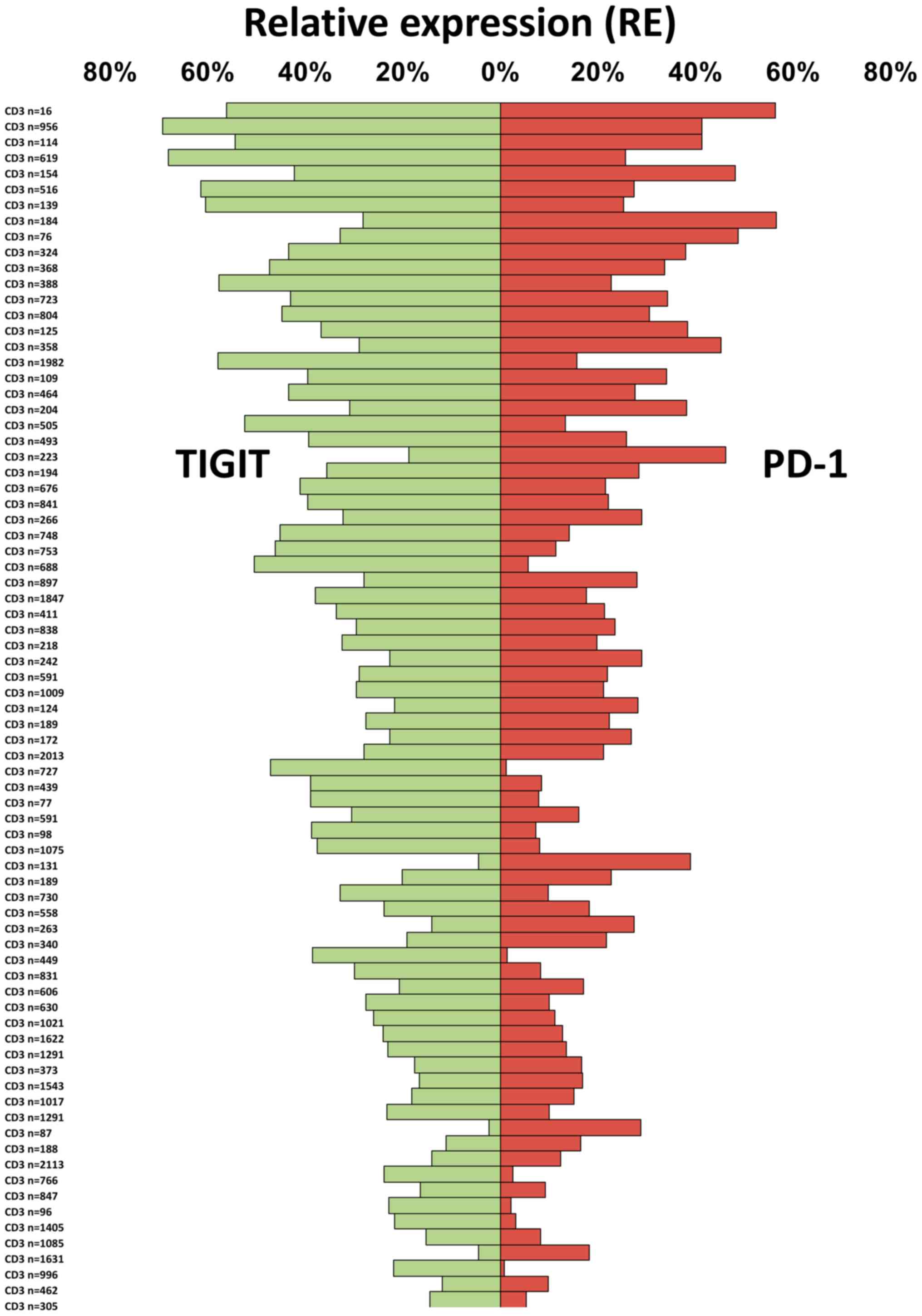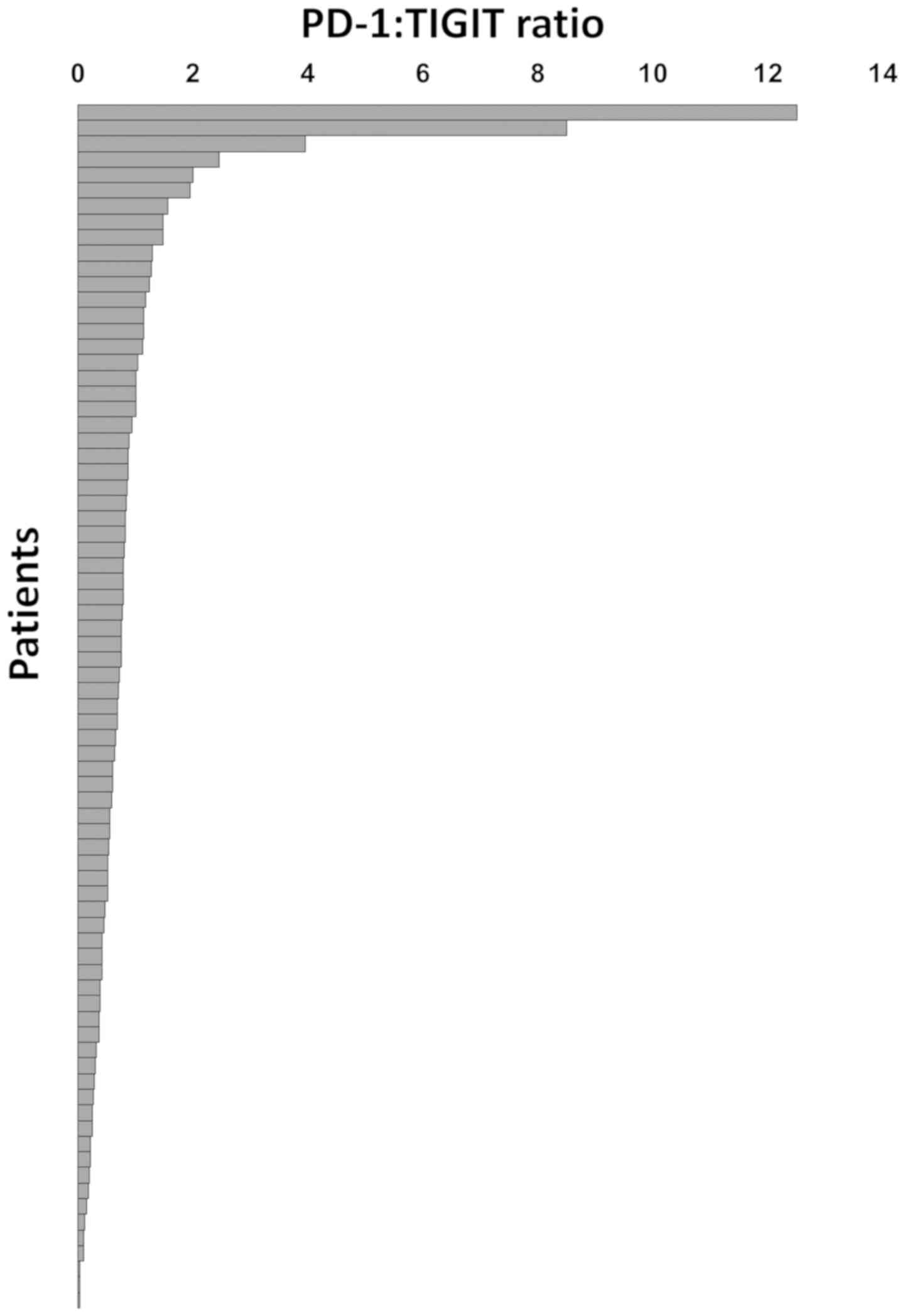|
1
|
Hayes-Lattin B and Nichols CR: Testicular
cancer: A prototypic tumor of young adults. Semin Oncol.
36:432–438. 2009. View Article : Google Scholar : PubMed/NCBI
|
|
2
|
Krege S, Beyer J, Souchon R, Albers P,
Albrecht W, Algaba F, Bamberg M, Bodrogi I, Bokemeyer C,
Cavallin-Ståhl E, et al: European consensus conference on diagnosis
and treatment of germ cell cancer: A report of the second meeting
of the European Germ Cell Cancer Consensus group (EGCCCG): Part I.
Eur Urol. 53:478–496. 2008. View Article : Google Scholar : PubMed/NCBI
|
|
3
|
Hanna N and Einhorn LH: Testicular cancer:
A reflection on 50 years of discovery. J Clin Oncol. 32:3085–3092.
2014. View Article : Google Scholar : PubMed/NCBI
|
|
4
|
Adra N and Einhorn LH: Salvage therapy for
relapsed testicular cancer. Oncotarget. 8:69200–69201. 2017.
View Article : Google Scholar : PubMed/NCBI
|
|
5
|
Oing C, Alsdorf WH, von Amsberg G, Oechsle
K and Bokemeyer C: Platinum-refractory germ cell tumors: An update
on current treatment options and developments. World J Urol.
35:1167–1175. 2017. View Article : Google Scholar : PubMed/NCBI
|
|
6
|
Zschäbitz S, Lasitschka F, Hadaschik B,
Hofheinz RD, Jentsch-Ullrich K, Grüner M, Jäger D and Grüllich C:
Response to anti-programmed cell death protein-1 antibodies in men
treated for platinum refractory germ cell cancer relapsed after
high-dose chemotherapy and stem cell transplantation. Eur J Cancer.
76:1–7. 2017. View Article : Google Scholar : PubMed/NCBI
|
|
7
|
Adra N, Einhorn LH, Althouse SK,
Ammakkanavar NR, Musapatika D, Albany C, Vaughn D and Hanna NH:
Phase II trial of pembrolizumab in patients with platinum
refractory germ-cell tumors: A hoosier cancer research network
study GU14-206. Ann Oncol. 29:209–214. 2018. View Article : Google Scholar : PubMed/NCBI
|
|
8
|
Ansell SM, Lesokhin AM, Borrello I,
Halwani A, Scott EC, Gutierrez M, Schuster SJ, Millenson MM, Cattry
D, Freeman GJ, et al: PD-1 blockade with nivolumab in relapsed or
refractory Hodgkin's lymphoma. N Engl J Med. 372:311–319. 2015.
View Article : Google Scholar : PubMed/NCBI
|
|
9
|
Wolchok JD, Kluger H, Callahan MK, Postow
MA, Rizvi NA, Lesokhin AM, Segal NH, Ariyan CE, Gordon RA, Reed K,
et al: Nivolumab plus ipilimumab in advanced melanoma. N Engl J
Med. 369:122–133. 2013. View Article : Google Scholar : PubMed/NCBI
|
|
10
|
Alsaab HO, Sau S, Alzhrani R, Tatiparti K,
Bhise K, Kashaw SK and Iyer AK: PD-1 and PD-L1 checkpoint signaling
inhibition for cancer immunotherapy: Mechanism, combinations, and
clinical outcome. Front Pharmacol. 8:5612017. View Article : Google Scholar : PubMed/NCBI
|
|
11
|
Chovanec M, Cierna Z, Miskovska V,
Machalekova K, Svetlovska D, Kalavska K, Rejlekova K, Spanik S,
Kajo K, Babal P, et al: Prognostic role of programmed-death ligand
1 (PD-L1) expressing tumor infiltrating lymphocytes in testicular
germ cell tumors. Oncotarget. 8:21794–21805. 2017. View Article : Google Scholar : PubMed/NCBI
|
|
12
|
Cierna Z, Mego M, Miskovska V, Machalekova
K, Chovanec M, Svetlovska D, Hainova K, Rejlekova K, Macak D,
Spanik S, et al: Prognostic value of programmed-death-1 receptor
(PD-1) and its ligand 1 (PD-L1) in testicular germ cell tumors. Ann
Oncol. 27:300–305. 2016. View Article : Google Scholar : PubMed/NCBI
|
|
13
|
Liu XG, Hou M and Liu Y: TIGIT, a novel
therapeutic target for tumor immunotherapy. Immunol Invest.
46:172–182. 2017. View Article : Google Scholar : PubMed/NCBI
|
|
14
|
Manieri NA, Chiang EY and Grogan JL:
TIGIT: A key inhibitor of the cancer immunity cycle. Trends
Immunol. 38:20–28. 2017. View Article : Google Scholar : PubMed/NCBI
|
|
15
|
Dougall WC, Kurtulus S, Smyth MJ and
Anderson AC: TIGIT and CD96: New checkpoint receptor targets for
cancer immunotherapy. Immunol Rev. 276:112–120. 2017. View Article : Google Scholar : PubMed/NCBI
|
|
16
|
Johnston RJ, Comps-Agrar L, Hackney J, Yu
X, Huseni M, Yang Y, Park S, Javinal V, Chiu H, Irving B, et al:
The immunoreceptor TIGIT regulates antitumor and antiviral CD8(+) T
cell effector function. Cancer Cell. 26:923–937. 2014. View Article : Google Scholar : PubMed/NCBI
|
|
17
|
Chauvin JM, Pagliano O, Fourcade J, Sun Z,
Wang H, Sander C, Kirkwood JM, Chen TH, Maurer M, Korman AJ and
Zarour HM: TIGIT and PD-1 impair tumor antigen-specific
CD8+ T cells in melanoma patients. J Clin Invest.
125:2046–2058. 2015. View
Article : Google Scholar : PubMed/NCBI
|
|
18
|
Kurtulus S, Sakuishi K, Ngiow SF, Joller
N, Tan DJ, Teng MW, Smyth MJ, Kuchroo VK and Anderson AC: TIGIT
predominantly regulates the immune response via regulatory T cells.
J Clin Invest. 125:4053–4062. 2015. View
Article : Google Scholar : PubMed/NCBI
|
|
19
|
Blessin NC, Simon R, Kluth M, Fischer K,
Hube-Magg C, Li W, Makrypidi-Fraune G, Wellge B, Mandelkow T,
Debatin NF, et al: Patterns of TIGIT expression in normal lymphatic
tissue, inflammation, and cancer. Dis Markers. 2019:51605652019.
View Article : Google Scholar : PubMed/NCBI
|
|
20
|
Garber K: Industry ‘road tests’ new wave
of immune checkpoints. Nat Biotechnol. 35:487–488. 2017. View Article : Google Scholar : PubMed/NCBI
|
|
21
|
Kong Y, Zhu L, Schell TD, Zhang J, Claxton
DF, Ehmann WC, Rybka WB, George MR, Zeng H and Zheng H: T-cell
immunoglobulin and ITIM domain (TIGIT) associates with CD8+ T-Cell
exhaustion and poor clinical outcome in AML patients. Clin Cancer
Res. 22:3057–3066. 2016. View Article : Google Scholar : PubMed/NCBI
|
|
22
|
Kononen J, Bubendorf L, Kallioniemi A,
Bärlund M, Schraml P, Leighton S, Torhorst J, Mihatsch MJ, Sauter G
and Kallioniemi OP: Tissue microarrays for high-throughput
molecular profiling of tumor specimens. Nat Med. 4:844–847. 1998.
View Article : Google Scholar : PubMed/NCBI
|
|
23
|
JMP® V: SAS Institute Inc.; Cary, NC:
https://www.jmp.com/1989-2019
|
|
24
|
Josefsson SE, Huse K, Kolstad A, Beiske K,
Pende D, Steen CB, Inderberg EM, Lingjærde OC, Østenstad B, Smeland
EB, et al: T cells expressing checkpoint receptor TIGIT are
enriched in follicular lymphoma tumors and characterized by
reversible suppression of T-cell receptor signaling. Clin Cancer
Res. 24:870–881. 2018. View Article : Google Scholar : PubMed/NCBI
|
|
25
|
Luo Q, Deng Z, Xu C, Zeng L, Ye J, Li X,
Guo Y, Huang Z and Li J: Elevated expression of immunoreceptor
tyrosine-based inhibitory motif (TIGIT) on T lymphocytes is
correlated with disease activity in rheumatoid arthritis. Med Sci
Monit. 23:1232–1241. 2017. View Article : Google Scholar : PubMed/NCBI
|
|
26
|
Yu X, Harden K, Gonzalez LC, Francesco M,
Chiang E, Irving B, Tom I, Ivelja S, Refino CJ, Clark H, et al: The
surface protein TIGIT suppresses T cell activation by promoting the
generation of mature immunoregulatory dendritic cells. Nat Immunol.
10:48–57. 2009. View Article : Google Scholar : PubMed/NCBI
|
|
27
|
Necchi A, Giannatempo P, Raggi D, Mariani
L, Colecchia M, Farè E, Monopoli F, Calareso G, Ali SM, Ross JS, et
al: An open-label randomized phase 2 study of durvalumab alone or
in combination with tremelimumab in patients with advanced germ
cell tumors (APACHE): Results from the first planned interim
analysis. Eur Urol. 75:201–203. 2019. View Article : Google Scholar : PubMed/NCBI
|
|
28
|
Topalian SL, Hodi FS, Brahmer JR,
Gettinger SN, Smith DC, McDermott DF, Powderly JD, Carvajal RD,
Sosman JA, Atkins MB, et al: Safety, activity, and immune
correlates of anti-PD-1 antibody in cancer. N Engl J Med.
366:2443–2454. 2012. View Article : Google Scholar : PubMed/NCBI
|
|
29
|
Farkona S, Diamandis EP and Blasutig IM:
Cancer immunotherapy: The beginning of the end of cancer? BMC Med.
14:732016. View Article : Google Scholar : PubMed/NCBI
|
|
30
|
Siska PJ, Johnpulle RAN, Zhou A, Bordeaux
J, Kim JY, Dabbas B, Dakappagari N, Rathmell JC, Rathmell WK,
Morgans AK, et al: Deep exploration of the immune infiltrate and
outcome prediction in testicular cancer by quantitative multiplexed
immunohistochemistry and gene expression profiling. Oncoimmunology.
6:e13055352017. View Article : Google Scholar : PubMed/NCBI
|
|
31
|
Mandelkow T, Blessin NC, Lueerss E, Pott
L, Simon R, Li W, Wellege B, Debatin NF, Hoflmayer D, Izbicki JR,
et al: Immune exclusion is frequent in small cell carcinoma of the
bladder. Disease Markers. Article ID 2532518. 2019. View Article : Google Scholar : PubMed/NCBI
|
|
32
|
Garcia-Martinez E, Gil GL, Benito AC,
González-Billalabeitia E, Conesa MA, García García T, García-Garre
E, Vicente V and Ayala de la Peña F: Tumor-infiltrating immune cell
profiles and their change after neoadjuvant chemotherapy predict
response and prognosis of breast cancer. Breast Cancer Res.
16:4882014. View Article : Google Scholar : PubMed/NCBI
|
|
33
|
Galon J, Costes A, Sanchez-Cabo F,
Kirilovsky A, Mlecnik B, Lagorce-Pagès C, Tosolini M, Camus M,
Berger A, Wind P, et al: Type, density, and location of immune
cells within human colorectal tumors predict clinical outcome.
Science. 313:1960–1964. 2006. View Article : Google Scholar : PubMed/NCBI
|
|
34
|
Fabre E, Jira H, Izard V, Ferlicot S,
Hammoudi Y, Theodore C, Di Palma M, Benoit G and Droupy S:
‘Burned-out’ primary testicular cancer. BJU Int. 94:74–78. 2004.
View Article : Google Scholar : PubMed/NCBI
|
|
35
|
Hanna NH and Einhorn LH: Testicular
cancer-discoveries and updates. N Engl J Med. 371:2005–2016. 2014.
View Article : Google Scholar : PubMed/NCBI
|
|
36
|
Feldman DR, Patil S, Trinos MJ, Carousso
M, Ginsberg MS, Sheinfeld J, Bajorin DF, Bosl GJ and Motzer RJ:
Progression-free and overall survival in patients with
relapsed/refractory germ cell tumors treated with single-agent
chemotherapy: Endpoints for clinical trial design. Cancer.
118:981–986. 2012. View Article : Google Scholar : PubMed/NCBI
|
|
37
|
Abouassaly R, Fossa SD, Giwercman A,
Kollmannsberger C, Motzer RJ, Schmoll HJ and Sternberg CN: Sequelae
of treatment in long-term survivors of testis cancer. Eur Urol.
60:516–526. 2011. View Article : Google Scholar : PubMed/NCBI
|
|
38
|
Wethal T, Kjekshus J, Røislien J, Ueland
T, Andreassen AK, Wergeland R, Aukrust P and Fosså SD:
Treatment-related differences in cardiovascular risk factors in
long-term survivors of testicular cancer. J Cancer Surviv. 1:8–16.
2007. View Article : Google Scholar : PubMed/NCBI
|
|
39
|
Ribas A, Puzanov I, Dummer R, Schadendorf
D, Hamid O, Robert C, Hodi FS, Schachter J, Pavlick AC, Lewis KD,
et al: Pembrolizumab versus investigator-choice chemotherapy for
ipilimumab-refractory melanoma (KEYNOTE-002): A randomised,
controlled, phase 2 trial. Lancet Oncol. 16:908–918. 2015.
View Article : Google Scholar : PubMed/NCBI
|
|
40
|
Brahmer J, Reckamp KL, Baas P, Crinò L,
Eberhardt WE, Poddubskaya E, Antonia S, Pluzanski A, Vokes EE,
Holgado E, et al: Nivolumab versus docetaxel in advanced
squamous-cell non-small-cell lung cancer. N Engl J Med.
373:123–135. 2015. View Article : Google Scholar : PubMed/NCBI
|
|
41
|
Li W, Blessin NC, Simon R, Kluth M,
Fischer K, Hube-Magg C, Makrypidi-Fraune G, Wellge B, Mandelkow T,
Debatin NF, et al: Expression of the immune checkpoint receptor
TIGIT in Hodgkin's lymphoma. BMC Cancer. 18:12092018. View Article : Google Scholar : PubMed/NCBI
|

















